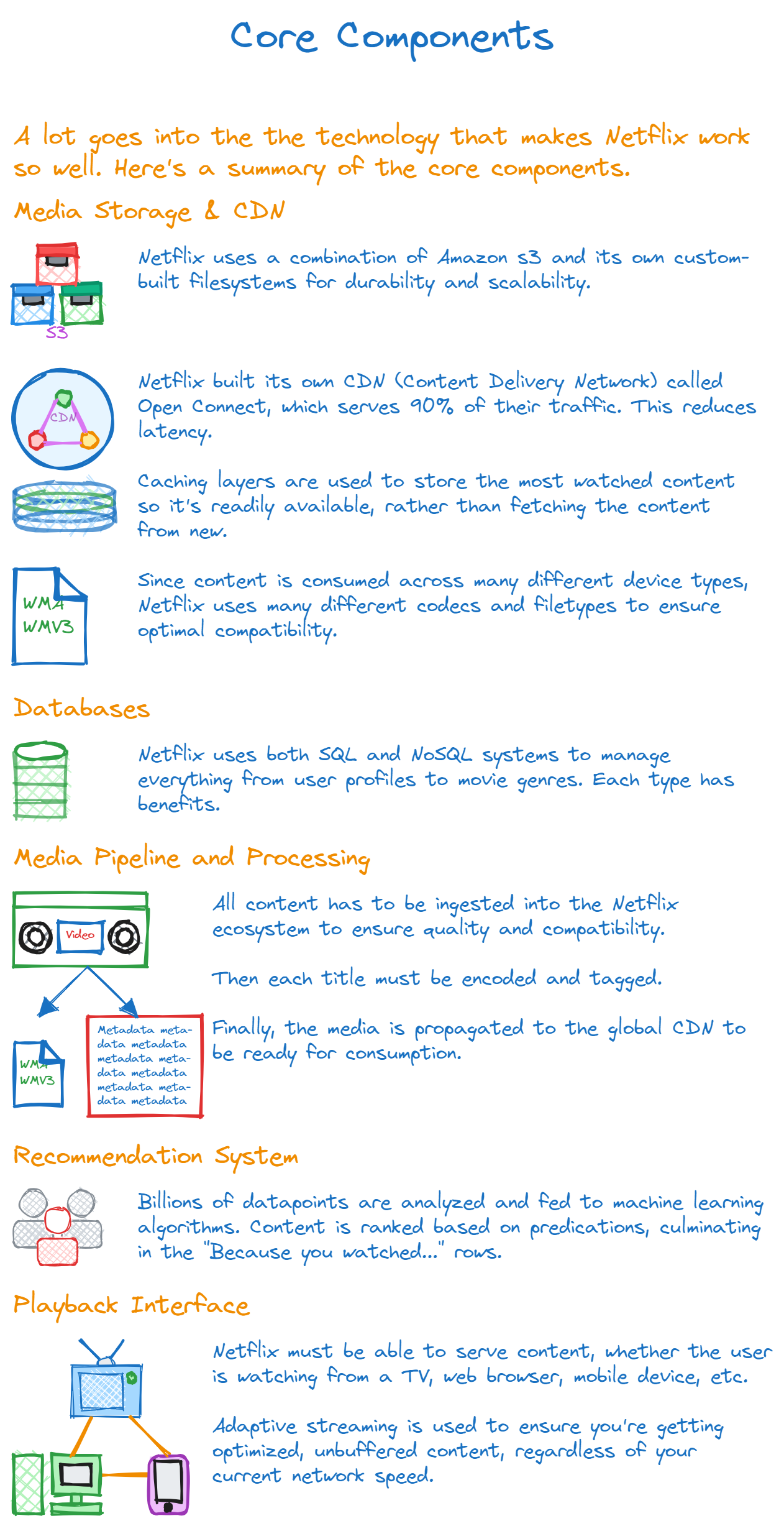Core Components

Peeling back the layers of Netflix's colossal streaming machine reveals a set of core components, each meticulously designed and orchestrated. These components ensure that when you hit 'play', you're not just streaming a show, but also experiencing the culmination of some of the most sophisticated tech systems in the world. Let's break down these core components:
Media Storage and CDN
Object Storage in S3 and Custom Filesystems: Storing petabytes of media files requires robust storage solutions. Netflix leans heavily on Amazon's Simple Storage Service (S3) for its durability and scalability. Additionally, they've designed custom filesystems tailored for rapid media access.
Content Delivery Networks (CDNs) like Open Connect: Netflix isn't content relying solely on third-party CDNs. They built their own, called Open Connect, which is responsible for serving 90% of their traffic. This global network of strategically placed servers ensures content is always close to viewers, reducing latency.
Caching Layers: A popular show might have millions viewing it concurrently. Instead of fetching it fresh for each viewer, Netflix employs intelligent caching layers to store and serve frequently accessed content, ensuring lightning-fast deliveries.
Media Encoding and Formats: Different devices have different capabilities. Netflix uses a myriad of codecs and formats, optimizing for device compatibility, network conditions, and even content type. They even re-encoded their entire library to save bandwidth without compromising quality.
Databases
MySQL, Cassandra, and DynamoDB for Metadata: Behind every show or movie you scroll past is a world of metadata. Netflix uses a mix of relational databases like MySQL and NoSQL solutions like Cassandra and DynamoDB to manage everything from user profiles to movie genres, ensuring rapid access and high availability.
Trade-offs with SQL and NoSQL Systems: Given the diverse set of operations and data types, Netflix employs a multi-database strategy. While SQL databases offer transactional consistency, NoSQL databases like Cassandra provide scalability and flexibility, especially useful for global operations.
Media Pipeline and Processing
Ingestion: Before a show reaches your screen, it's ingested into the Netflix ecosystem, undergoing a series of checks for quality, compatibility, and more.
Encoding and Tagging Media Files: Each title is encoded into multiple formats and resolutions. Additionally, they're tagged with metadata, ensuring the right subtitles, audio tracks, and descriptions accompany your stream.
Making Content Ready for Streaming: The processed media is then propagated to the global CDN, ensuring it's ready for streaming to viewers everywhere, irrespective of the device or network condition.
Recommendation System
Analytics on Viewer Habits: The average Netflix user spends just 1.8 seconds considering each title while browsing. The recommendation engine processes billions of data points, from viewing history to browsing habits, ensuring you find your next binge-worthy show in a snap.
Ranking and Machine Learning Algorithms: Underpinning the recommendation system are complex ML models. They rank content based on predicted relevance, ensuring your homepage feels uniquely tailored.
Related Content Suggestions: Ever noticed the "Because you watched..." rows? These are clusters of related content, using multiple similarity metrics, guiding you seamlessly from one show to the next.
Playback Interface
Device-specific UIs: Whether you're on a smart TV, mobile device, or browser, Netflix ensures a consistent yet device-optimized experience.
Buffering and Latency Minimization: Adaptive streaming techniques ensure you watch in the best quality your network allows, minimizing buffering. Even if the network drops, advanced algorithms predict the best bitrate to switch to, ensuring an uninterrupted viewing experience.
With these core components, Netflix has built a system that feels simple on the surface yet is astonishingly complex underneath. Up next, we'll dive into the architectural patterns that allow these components to work in harmony.

